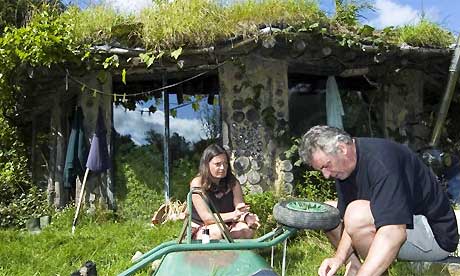Sunday, September 21, 2008
Science debate 2008: The answers are in
Anyone who still thought sustainability education isn't going to become a universal requirement in high schools and at college should read this. But who will teach all the teachers.?
We're in for a busy decade or two.
Saturday, September 20, 2008
Booth bliss




This year's Unity College MOFGA Fair booth was a team effort. Melora Norman collected the materials and made the booth-minding schedule and the students, pictured, filled it, for which they get in the fair for free.
Other booth minders are faculty and staff. Sandra Abbot-Stout, for instance is our gracious librarian, seated behind.
Thanks Melora, Sandy, students and all others who accepted booth-minding responsibility.
Rob Beranek made the President's House poster, behind, and helped me move the big bits of booth and displays to the site and put it all up. Thanks, Rob.
Jake Harr provided the car, which rhymes. Harr -car. Get it? A grease car.
Thanks Jake.
Sarah Trunzo made this quirky sign last year. Recycled. like the booth itself. Jake's grease car is behind.
And no UC display would be real without a Jimmy Carter solar panel. Here the photographer is reflected in the panel, while students mind the booth.
A very creditable turn-out. Thanks again, everyone.
Thursday, September 18, 2008
Welshcake and eat it too

Tony Wrench and Jane Faith outside their home in Brithdir Mawr, Wales. Photograph: Phil Rees/Rex Features. From The Guardian
Generations of Unity College students have built shelters in the woods, ranging from lean-tos and wickiups to serious cabins with wood heat. The temporary shelters abound, or their remains do, on the college property. Some were quite large. The more permanent shelters are often built on land owned by student "sympathizers" in the community, and while they usually lack building permits or taxation, they are often quite decent dwellings with wood heat and oil lamps or solar power.
Shelter is a basic human need, one that authorities tend to regulate quite strictly. While there's usually good reason for the regulation, it drives up costs for ordinary people, which is why so many of us, the author included, sweat away our lives to pay off mortgages on more formal "real" property. It's good to see some folks getting away with just being human and not having to pay very much for it. Now that's what I call "real" estate.
From the Guardian:
A secret ecovillage that was only discovered during an aerial survey of a Welsh national park will not be demolished after it was finally approved.
After a 10-year planning row, authorities at Brithdir Mawr, in Pembrokeshire, ruled that the settlement - made up of timber-framed, turf-roofed roundhouses resembling Bilbo Baggins' home in the Lord of the Rings - could stay.
The inhabitants secretly built the sustainable village and lived there unnoticed until the aerial survey was carried out in 1998.
The villagers were threatened with eviction and the authorities said the roundhouses, built of straw, timber, recycled glass, clay and manure, must be torn down.
However, the villagers fought back and, after a decade of hearings, court cases and inquiries, the settlement has been saved from destruction.
The village relies on solar power and a wind turbine for electricity, and has compost toilets, reed beds, a workshop and a hay barn.
Water is collected locally, and the villagers survive by working the land and carrying out craft industries such as woodcarving.
The Pembrokeshire coast national park authority gave the village the green light after it adopted a new policy on sustainable, low-impact developments.
A spokeswoman said that meant the community would have to make a "positive environmental and social/economic contribution to the area".
"It was pleasing that support could be given at this stage for this longstanding, complicated case," she said.
The national park authority will review the decision in three years.
Monday, September 15, 2008
UK farmers fight rain to bring in harvest
This year we had the mid-western floods, but the UK currently seems the epicenter of failed crops. The Guardian has a sequence of photos here.
Note the accompanying story. The UK media and public connect these events to climate change much more easily than do Americans with similar events.
Friday, September 12, 2008
Fall tilling
 This is Sara on the small Kubota 12-horse tractor, tilling up the beds in the community garden. In the background is the chicken tractor.
This is Sara on the small Kubota 12-horse tractor, tilling up the beds in the community garden. In the background is the chicken tractor.Sara and her various helpers (but mostly Sara) did such a good job this year with the garden, they made the papers. Check it out here.
Thursday, September 11, 2008
A jury of their peers...

From the Guardian article posted here
A Greenpeace activist abseils down the Kingsnorth power station in October 2007. Photograph Will Rose/Greenpeace
Six Greenpeace climate change activists have been cleared of causing £30,000 of criminal damage at a coal-fired power station in a verdict that is expected to embarrass the government and lead to more direct action protests against energy companies.
The jury of nine men and three women at Maidstone crown court cleared the six by a majority verdict. Five of the protesters had scaled a 200-metre chimney at Kingsnorth power station, Hoo, Kent, in October last year.
 Greenpeace activists on the painted chimney October 8 2008. Photograph: Will Rose/Greenpeace
Greenpeace activists on the painted chimney October 8 2008. Photograph: Will Rose/Greenpeace The activists admitted trying to shut down the station by occupying the smokestack and painting the word "Gordon" down the chimney, but argued that they were legally justified because they were trying to prevent climate change causing greater damage to property around the world. It was the first case in which preventing property damage caused by climate change had been used as part of a "lawful excuse" defence in court. It is now expected to be used more widely by environment groups.
In his summing-up at the end of an eight-day trial, the judge, David Caddick, said the case centred on whether or not the protesters had a lawful excuse for their actions. He told the jury that for this defence to be used it had to be proved that the action was due to an immediate need to protect property belonging to another.
He said allowance for demonstrations did not extend to breaking the law and the jury's task was to examine the boundary line represented by the lawful excuse and to evaluate whether the defendants had crossed the line. He also warned the jury to put aside any feelings towards Greenpeace, climate change or fuel companies during their deliberations.
John Price, prosecuting, had earlier argued that the protesters' actions were "not capable of being lawful". He said: "There are things you can lawfully do in making a protest but there's a line which has to be drawn. When the defendants caused damage to that chimney, it's the line that they crossed."
The court had heard from Professor Jim Hansen, one of the world's leading climate scientists, that the 20,000 tonnes of carbon dioxide emitted daily by Kingsnorth could be responsible for the extinction of up to 400 species. Hansen, a Nasa director who advises Al Gore, the former US presidential candidate turned climate change campaigner, told the court that humanity was in "grave peril". "Somebody needs to step forward and say there has to be a moratorium, draw a line in the sand and say no more coal-fired power stations."
It also heard David Cameron's environment adviser, millionaire environmentalist Zac Goldsmith, and an Inuit leader from Greenland both say climate change was already seriously affecting life around the world. Goldsmith told the court: "By building a coal-power plant in this country, it makes it very much harder [to exert] pressure on countries like China and India" to reduce their burgeoning use of the fossil fuel.
The court was told that some of the property in immediate need of protection included parts of Kent at risk from rising sea levels, the Pacific island state of Tuvalu and areas of Greenland. The defendants also cited the Arctic ice sheet, China's Yellow River region, the Larsen B ice shelf in Antarctica, coastal areas of Bangladesh and the city of New Orleans.
The jury was told that Kingsnorth emitted the same amount of carbon dioxide as the 30 least polluting countries in the world combined - and that there were advanced plans to build a new coal-fired power station next to the existing site on the Hoo peninsula.
Greenpeace used the court's decision to put pressure on the government to abandon plans for a new generation of coal-fired plants. "Today's acquittal is a potent challenge to the government's plans for new coal-fired stations from jurors representing ordinary people in Britain who, after hearing the evidence, supported the right to take direct action in order to protect the climate," said Ben Stewart, the group's communications director and one of the six acquitted. The others were Will Rose, Kevin Drake, Tim Hewke, Huw Williams and Emily Hall.
"It wasn't only us in the dock, it was coal-fired power generation as well," said Hall. "The only people left in Britain who think new coal is a good idea are business secretary John Hutton and the energy minister Malcolm Wicks. It's time the prime minister stepped in and embraced a clean energy future for Britain."
Friday, September 5, 2008
Athwart the thawt

Diagram from the Guardian article here.
Another new sustainable technology bulletin. This one is a new configuration for underwater tidal-flow turbines. Looks like a push-lawnmower.
The transverse horizontal axis water turbine or THAWT for short. Gives a projected 12 MW from an installation using a fraction of the concrete and steel of a standard wind turbine, or the newer marine turbines with the same horizontal-axis-and-airfoil configuration.
Of course, we will have to build one and see if it works. The fun part.
And we will need materials science and engineering capable of withstanding the corrosion and pressure.
Funny, though, how all these experimental configurations use the same Newtonian physics and fail to add much to our lexicon of engineering, beyond reconfiguration of axis and airfoil.
Somehow I find that reassuring. I learned this particular physics and engineering myself three decades ago as an RAF "fitter" trainee. Those months in the classrooms and shops at Number One Technical Traning School, RAF Halton, have stood me in incredibly good stead for so many new things in my life. I definitely owe a big professional debt to the men of that program. Even though the instructors were all b.....ds and the drill sergeants hated my skinny sproggy untidy guts. Still, the high pressure meant that the lessons stuck well. In 1978 there remained a 1940s Battle of Britain, shoulders to the wheel, feel to the ground crew training courses, and some of the more elderly instructors, the flight sergeants and chief techs, had actually been around in those stirring times. They could be tough teachers though. The toughest.
But less nostalgia. Back to task.
The nice thing about the tide is it happens twice a day, every day. With our current soggy, hurricane remnant weather from the south, it hasn't been windy here in Maine for quite a few hours and days. (A fact that our wind turbine crews on Freedom Ridge are probably happy with, since wind is actually a hazard in the construction phase.)
Springs and neeps will make for similar back-up capacity restrictions to those found in wind energy development, however, and a similar build-out percentage at some fraction of total need. With wind turbines this is posited as around 20%, but the Dutch and Danes feel they might be able to do better.
Still, this new technology, if it works and is cost-effective as the authors suggest, ought to be a good one to try in Maine.
Keeping track of R&D in sustainability tech is hard. There's so many areas to keep up with. If I had a job as a specialist, I could just delve into one small patch, hoe my own row, and reap the harvest.
That wouldn't do my students very much good though. At this sage, knowing the basic principles and a little bit about each kind and configuration of renewable energy device is best. Actually betting on winners and losers is a job for the market, or occasionally for government, and particularly for chancy young dudes in suits and flash cars with (generally someone else's) money to burn, not for grey-bearded old lags like me.
I just read the news and tech papers and call it as I see it.
Caveat emptor.
Wednesday, September 3, 2008
What should a sustainability scientist study?

Sustainability science, of course. This according to the Proceedings of the National Academy of Science
Just another example, albeit more prestigious than most, of a) how widespread and mainstream the term sustainability has become, and b) how the issues of climate change, energy concerns, efficient and resilient agriculture, and biodiversity are converging.
Although the breadth and depth of what appears in their new journal offering seems more than most mere mortals could cope with, one good test of a decent, well-trained, well-rounded environmental scientist for the twenty-first century would be, well, can you figure out most of, most of these articles.
Tuesday, September 2, 2008
The ugly sister
Gustav no longer the "mother of all storms," just the ugly sister. That according to the Mayor of N.O.
The storm surge topped the dykes, but didn't significantly breach them or flow over. Just. A hair's breadth in some cases. Kudos to the engineers who got them repaired and to a good evacuation plan. We were also extremely lucky. But there'll be another, and another, hurricane coming.
The person who summed up my incredulity that we still refuse to learn climate lessons the most, was the woman who said on the radio how "angry" residents were to have to suffer another storm so hard on the heels of Katrina.
Getting angry at Mother Nature for doing what she's gonna do. Intelligent, that.
Imagine if New Englanders, instead of having food, fuel, water in their houses, as well as generators and plow trucks, and watching the weather all winter, got angry at ice and snow storms. Another blizzard? That just makes me mad. We're so angry to live in New England and have these awful, awful...
...winters.
The expectation seems to be that the frequency of hurricanes is something that the authorities could fix, if they wanted. Outstanding.
Another reason why climate and climate change education needs to be mandatory and in the high schools as well as colleges. But at least FEMA, the city, and the state have learned some. Not enough to be completely safe. They obviously shaved some on the pace and cost of levee repair, or it wouldn't have been such a close-run thing. Apparently one Dutch commentator, a levee expert, mentioned that there's thirty years of work needed to save that city. But they definitely brooked no backtalk and got all the people out, and that was smart.
Thirty years in which the sea level rise will very likely accelerate due to the general melt in Greenland and Antarctica.